Original author: flowie, ChainCatcher
Although RWA has always struggled with skepticism about repeating old stories, since the beginning of the year, RWA has continuously attracted institutions to join and "contribute bricks and tiles" to it. The rising trend of RWA concept tokens has indeed brought some highlights to the sluggish cryptocurrency market.
At the beginning of the year, we briefly analyzed the reasons behind the rise of RWA in the article "RWA, which is being sought after by major institutions such as Binance and Goldman Sachs, is it the next growth engine for DeFi or a fleeting trend?". At that time, major institutions such as Binance, Goldman Sachs, Hamilton Lane, and Siemens entered the scene one after another, and the intensive layout of some on-chain US bond agreements attracted attention to RWA. Behind the concentrated surge of on-chain bonds, a key driving factor is that the low returns of DeFi in the bear market cannot meet the profit needs of cryptocurrency users. With the continuous interest rate hikes by the Federal Reserve, on-chain US bonds do provide a new profit solution for cryptocurrency users.
After a few months, under the narrative of regulatory crackdown by the US SEC, the entry of TradFi institutions such as BlackRock applying for a Bitcoin spot ETF, RWA may once again break out due to compliance-related contexts. Recently, there have been a series of events in the RWA field that have attracted attention:
Compound founder establishes a new company "Superstate" and seeks to tokenize US bonds on Ethereum;
Maker purchases $700 million worth of US bonds and raises the investment limit for short-term US bonds to $1.28 billion;
Of particular note is the entry of national teams: China CITIC Bank International issued HKD 200 million digital notes through UBS, which is the first such product compliant with Hong Kong and Swiss laws and tokenized on the Ethereum blockchain.
The change in the attitude of the Securities and Futures Commission (SFC) of Hong Kong towards RWA assets. Elizabeth Wong, Director of Fintech at SFC, stated in an interview with Eliptic that SFC will soon introduce an update, Securities Tokens or RWA will not be defined as complex products and will have the opportunity to be open to retail investors. RWA will be regulated based on underlying assets.
In addition, Sun Yuchen, who never misses any hotspots, has also been active. On July 4th, the TRON ecosystem announced the launch of the RWA stable pledging product stUSDT, allowing users to pledge USDT to obtain RWA rewards.
After months of preparation at the beginning of the year, with the consecutive assists from the old DeFi protocols and the entrance of national teams, the reaction in the secondary market of RWA was strong, and tokens such as MRK and COMP surged significantly.
At the same time, compared to the first half of the year, the crypto community's doubts about RWA seem to have eased, and there are also such sentiments: many Crypto natives nowadays sneer at RWA just like they did to DeFi Summer in 2020, and the result is that they missed a wave of innovation.
Due to the broad definition of the RWA concept, the actual development of this field feels vague. This article mainly combines the RWA section of the encrypted data platform RootData to sort out the specific progress of the leading projects under the RWA concept and some early projects that have highlights in terms of financing or models, providing an overview of the development of the RWA track.
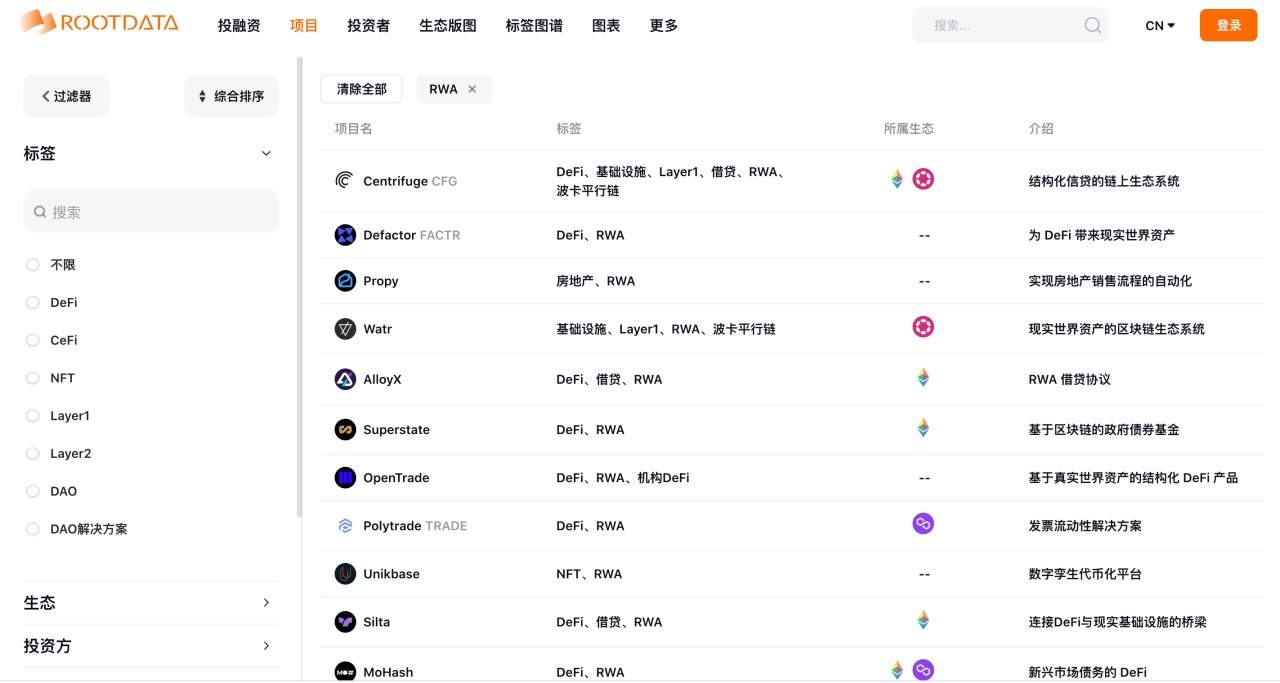
Latest progress of representative projects in the RWA field
According to the data compiled by CoinMarketCap, the total market value of RWA concept tokens currently exceeds 2 billion USD.

In addition to some well-established DeFi projects, the overall RWA projects are in the early stages. First, let's organize the leading projects in different sub-fields to understand their actual progress or future plans in the RWA planning over the past six months when RWA continues to heat up. Overall, the top 10 RWA concept tokens with higher market value have all increased in the past month, with Compound having the highest increase, exceeding 100%.
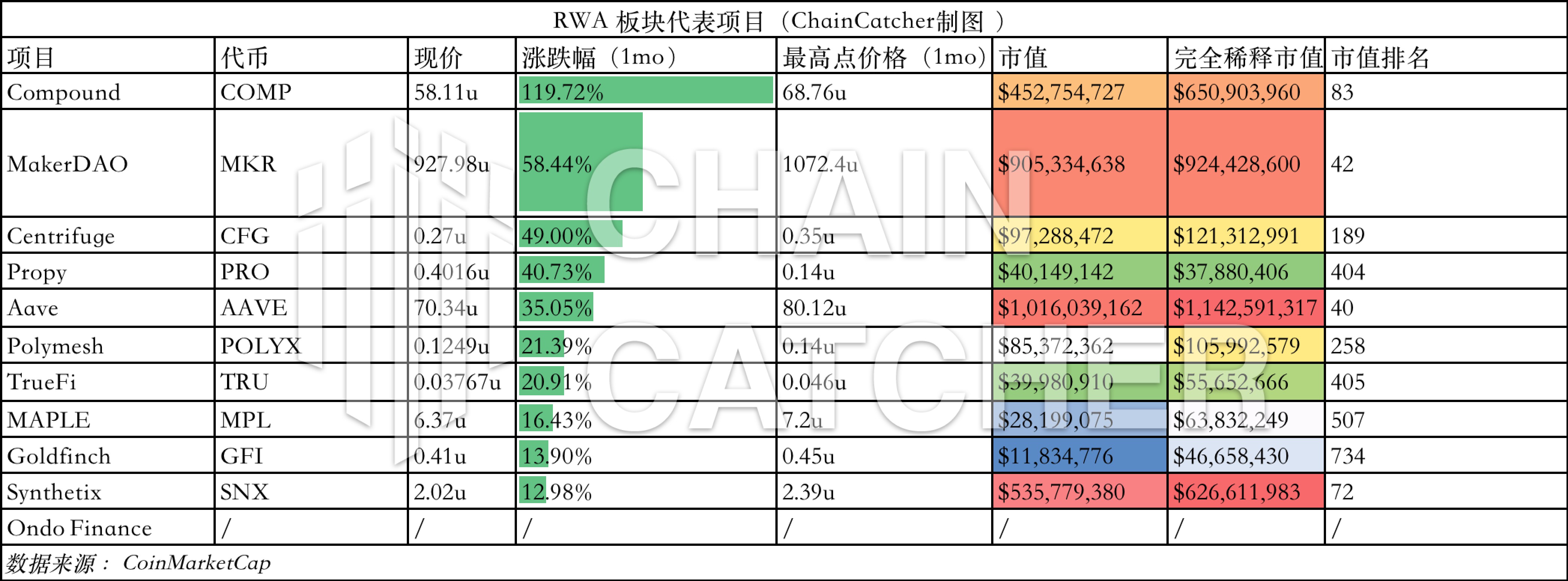
On-chain Treasury Bonds
1. MakerDAO (MKR)
The stablecoin DAI issued by MakerDAO pegged to the US dollar is one of the most common use cases for RWA. MakerDAO is also an early DeFi protocol that included RWA in its strategic planning. In 2020, it passed a proposal to tokenize real estate, invoices, and receivables as collateral for DAI issuance.
MakerDAO has established multiple RWA vaults, with most of the collateral being Treasury bonds. This year, amidst the overall downturn in DeFi, MakerDAO has continued to expand its RWA holdings, particularly focusing on Treasury bonds.
Source of MakerDAO's RWA vaults: Source: Dune Analytics (@SebVentures), Binance Research
In April, MakerDAO approved the opening of a Real-World Assets (RWA) vault for Coinbase custody service, with a transfer of up to $500 million in USDC stablecoins. The Coinbase custody department will offer an annual interest rate of 2.6% for the deposits.
In June, MakerDAO made purchases and investments in Treasury bonds through RWA vaults. First, MakerDAO passed a governance vote to add BlockTower Andromeda (RWA 015) as a new vault type for real-world assets (RWA). This vault, managed by asset management company BlockTower Capital, will invest in short-term US Treasury bonds with a maximum of $1.28 billion, using DAI overcollateralized stablecoins from Maker. Maker will pay BlockTower Capital a fee of 0.15%.
Shortly afterwards, MakerDAO purchased $700 million worth of US Treasury bonds through the digital asset management company Monetalis Clydesdale Vault. In addition to the initial purchase of $500 million in bonds in October 2022, MakerDAO's total bond holdings now exceed $1.2 billion.
By allocating assets in the balance sheet more effectively between government bonds and investment-grade bonds, and increasing the fees charged to DAI borrowers, MakerDAO has seen significant growth in revenue. According to Defilama data, MakerDAO's profits reached $8.32 million in June, compared to $5.48 million in May and just over $3 million before April. With the increase in revenue and profits, MakerDAO announced in June that the DAI deposit rate would be raised from 1% to 3.49%, more than tripling.
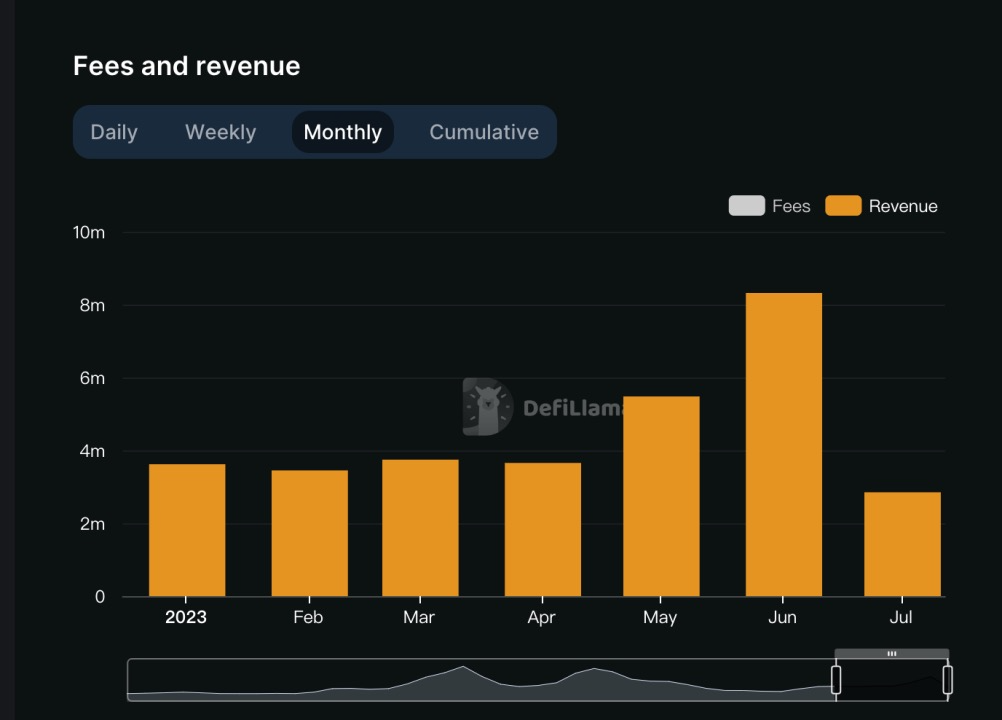
According to Dune panel data analysis compiled by @SebVentures, MakerDAO's RWA assets are gradually expanding, accounting for 45% of its total assets, far exceeding the stablecoin assets which make up 26% and contributing more than 52% of MakerDAO's income.
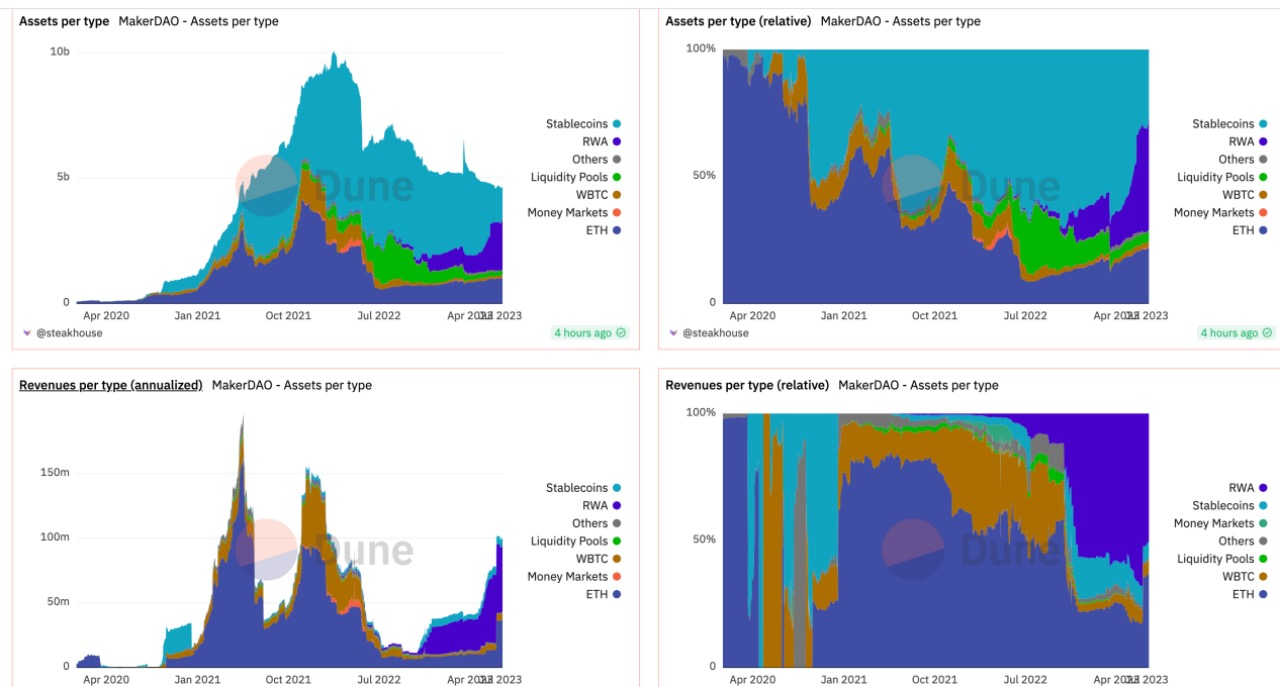
2. Compound (COMP)
Unlike MakerDAO, which has always been focused on RWA, Compound's sudden announcement of the establishment of a new company called Superstate, focused on on-chain bonds, has quickly sparked the market.
It is reported that Superstate's fund will invest in "ultra-short-term government securities", including U.S. Treasury bonds, government agency securities, and other government-supported instruments. Superstate announced that it has completed the seed financing round, but the specific amount of financing has not been disclosed. ParaFi Capital, 1kx, Cumberland, CoinFund, and Distributed Global participated in this round of financing. However, Superstate is still in the application stage.
3, Aave (AAVE)
Aave followed MakerDAO's footsteps by announcing the launch of the RWA market in 2021, which also allows collateralized lending with real assets. Like MakerDAO, Aave has adopted Centrifuge as its RWA provider, and its RWA market enables Aave depositors to earn income from real-world collateral, while Centrifuge asset originators can borrow funds from Aave. Currently, the size of Aave's RWA market is around $7.635 million, and only the USDC market can still provide deposit and lending APY, while other markets no longer do.
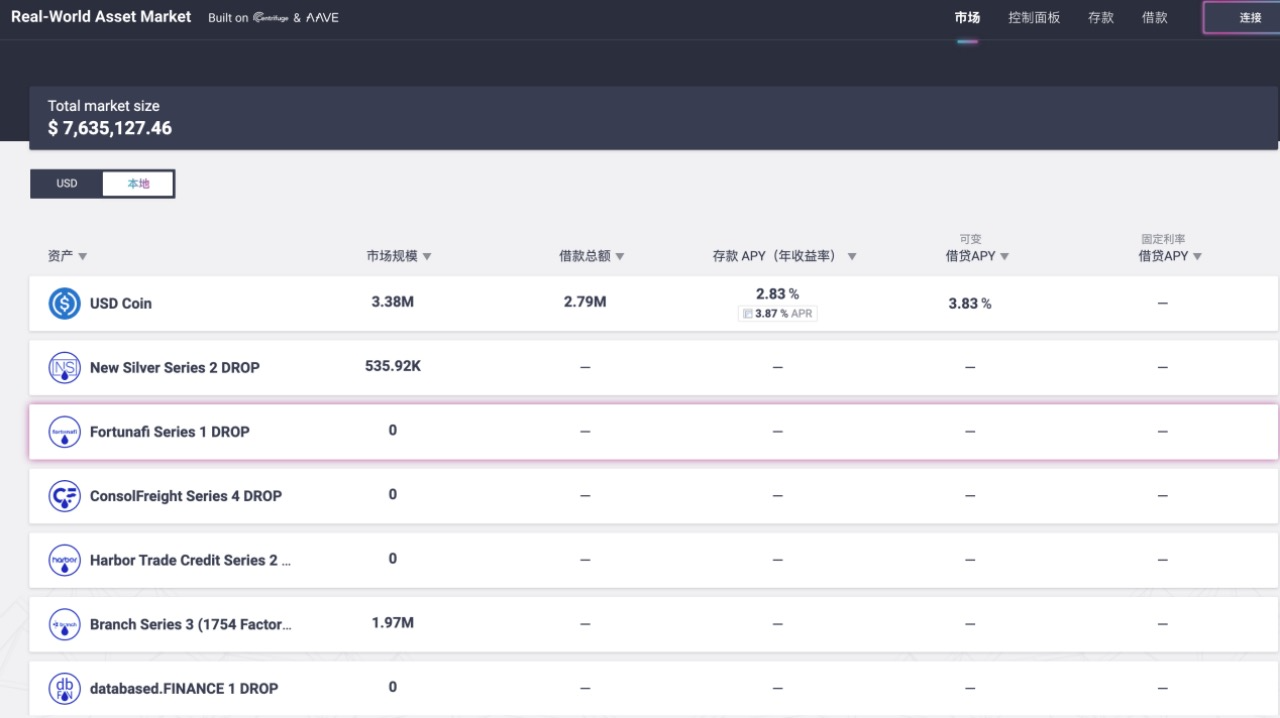
In February of this year, Aave's native stablecoin GHO launched its testnet. GHO is an over-collateralized stablecoin supported by multiple crypto assets. Subsequently, the lending protocol Centrifuge proposed to introduce RWA into Aave and use it as collateral for the native stablecoin GHO.
In June, the Aave community initiated the ARFC proposal for the "mainnet launch of the native stablecoin GHO". If the proposal is approved, GHO will operate on the Ethereum mainnet, and Aave V3 users on Ethereum will be able to use collateral to mint GHO. The DAO treasury will receive 100% of the interest income from GHO lending as additional revenue.
With MakerDAO and Compound continuing to make efforts in RWA, Aave is also rumored to be stepping up its pace in RWA.
4, Ondo Finance
Ondo Finance was founded in 2021, with team members from various institutions and DeFi protocols such as Goldman Sachs, Fortress, Bridgewater, and MakerDAO. Ondo Finance has currently raised $34 million in investment from notable institutions such as Pantera Capital, Coinbase Ventures, Tiger Global, and Wintermute.
Ondo Finance launched a tokenized fund earlier this year, allowing stablecoin holders to invest in bonds and US Treasury bonds. Ondo Finance currently supports four investment funds - US Money Market Fund (OMMF), US Treasury Bonds (OUSG), Short-Term Bonds (OSTB), and High-Yield Bonds (OHYG), which are marked as RWAs (referred to as "fund tokens"). Users can trade fund tokens and use them in permitted DeFi protocols after completing the KYC/AML process.
The Ondo Finance team also developed a decentralized lending protocol, Flux Finance, which specifically invests in BlackRock's iShares Short Treasury Bond ETF (SHV). The protocol offers various tokens available for lending, such as USDC, DAI, USDT, and FRAX, with OUSG being the only collateral asset. OUSG holders who have gone through KYC can deposit OUSG into Flux Finance for lending, while borrowers can provide stablecoins to earn returns. Flux Finance has already launched on the Ethereum mainnet earlier this year.
According to data analysis from Dune, the existing market value of bond tokens exceeds $200 million, with Ondo (OUSG) holding nearly 50% of the market share, with a market value of over $130 million. The current TVL (Total Value Locked) on Flux Finance has also surpassed $40 million.
Lending
5. Centrifuge (CFG)
Founded in Centrifuge is one of the earliest DeFi protocols involved in RWA, and also the technical provider behind top protocols such as MakerDAO and Aave. Currently, Centrifuge has a total of 17 RWA asset pools.
According to the latest semi-annual report released by Centrifuge, BlockTower, the $220 million RWA treasury deployed by MakerDAO this year, has brought tremendous growth to Centrifuge, helping its TVL rise to $210 million.
Another significant development is the launch of Centrifuge Prime, a service and technology suite that helps DeFi protocols support RWA. Centrifuge Prime includes a compliant legal framework specifically designed for DAOs and DeFi protocols, a sophisticated tokenization and issuance platform, decentralized and objective credit risk and financial reporting, as well as diverse asset categories and issuers, addressing many KYC and legal recourse issues. It is worth mentioning that with the booming RWA, Centrifuge will be hosting an RWA-themed summit in New York on September 19th, which is worth paying attention to.
However, Centrifuge's RWA asset pools have also been reported to have some bad debt issues. According to data from rwa.xyz, a blockchain credit analysis platform, there are approximately $5.8 million in unpaid loans in Centrifuge's two lending pools, including consumer loans, invoices, and trade accounts receivable.
The most troubled lending pool on Centrifuge is the one that provided funding to 1754 Factory for the purchase of short-term capital point payment bonds and provided small loans to French customers of Bling FinTech applications. All 16 active loans in this pool, worth approximately $5.1 million, have exceeded the repayment period, and some loans have been overdue for more than 150 days. In addition, there are 4 overdue payments in its REIF pool, which provided funding for commercial real estate mortgages, valued at $3.3 million.
6. Goldfinch (GFI)
Although Goldfinch, created by former Coinbase employees, entered the market later than Centrifuge, it has secured large-scale financing from well-known institutions with its innovative model. According to RootData data, Goldfinch has completed 3 rounds of financing, raising a total of 37 million US dollars, with participation from a16z, SV Angel, Alliance DAO, Balaji Srinivasan, Ryan Selkis, and others.
Goldfinch primarily provides loans to debt funds and fintech companies, offering USDC credit lines to borrowers and supporting the conversion of those lines into fiat currency. Goldfinch's model is similar to traditional banking in the financial industry, but it has decentralized auditors, lenders, and credit analysts. Auditors assessing borrowers' audits must possess pledging governance tokens (GFI). Goldfinch can offer high returns as its collateral requirements are low, allowing borrowers on Goldfinch to pay interest rates of 10-12%. Currently, there have been no cases of bad debt.
Earlier this year, Goldfinch announced a pilot project that only provided credit on Goldfinch by utilizing on-chain cash flow. Furthermore, Goldfinch introduced a new transaction structure: redeemable loans. This product allows investors to choose to retrieve their investment before the loan's final maturity date. For the first transaction, the call-payment term will be set every 3 months and require a 60-day advance notice, but these parameters are customizable in the smart contract of the product.
Goldfinch also announced a 2 million US dollar transaction launch with fintech company Fazz Financial, which offers users a fixed annual interest rate of 13% on USDC, supports 90-day redeemable loans, and requires a 60-day advance notice. It is worth mentioning that this alternative asset class is not affected by fluctuations in the cryptocurrency or stock market, as its returns come from real-world economic activities. This issuance will not be registered with any securities regulatory authority under the U.S. Securities Act of 1933 or any state or other jurisdiction in the United States. Users participating in this issuance are limited to U.S. accredited investors and non-U.S. persons who have completed accredited investor verification through Parallel Markets.
7. MAPLE (MPL)
Compared to private lending agreements with asset guarantees, Maple provides highly active loans during bull markets because of its unsecured model. Unlike Maple and Goldfinch, which rely on users for auditing, Maple employs professional credit reviewers to rigorously assess borrowers' creditworthiness. However, under the unsecured model, Maple suffered $52 million in bad debts due to the collapse of Three Arrows Capital, FTX, and others, and its requirement for KYC in borrowing raised controversy for lacking decentralization. Recently, Maple has expanded its lending model to include mortgages backed by real assets to reduce risks.
In April of this year, Maple Finance announced the launch of a US Treasury pool, causing its token, MPL, to surge by over 20%.
According to Maple Finance's latest report on the first half of 2023 and progress in the second half, the company has reduced concentration and default risks through new loan products. 1) Open term loans will allow users to withdraw loans at any time and manage concentration risks and liquidity required for withdrawals more effectively; 2) Active collateral management allows users to request that the value of collateral be maintained above a specific threshold and reduce capital losses in case of default; 3) Reduction in refinancing capital will allow refinancing to be requested even when the borrower's creditworthiness declines, reducing capital losses in case of default and managing concentration risks more effectively.
8. TrueFi (TRU)
TrueFi is an unsecured lending protocol driven by on-chain credit scoring. Since its launch in November 2020, TrueFi has lent over $1.7 billion to more than 30 borrowers and paid over $40 million in interest to protocol participants. Borrowers include leading cryptocurrency institutions, as well as fintech companies, credit funds, and traditional financial institutions.
TrueFi has raised over $30 million in funding, with participation from 16z Crypto, BlockTower Capital, Foundation Capital, Distributed Global, Zhen Fund, GGV Capital, Jump Trading, DHVC, and others.
Synthetic Assets
9. Synthetix (SNX)
Synthetix is a decentralized synthetic asset protocol, where users can mint synthetic assets (sUSD) Synths by staking SNX. It supports not only synthetic stablecoins but also tracks the prices of forex, stocks, commodities, and more using synthetic assets.
In March of this year, Synthetix completed a $20 million financing from DWF Labs and announced that DWF Labs would provide liquidity and market makers for SNX. Additionally, Synthetix released version 3, which added more types of collateral assets, EVM compatibility, cross-chain deployment support, and optimized developer tools.
Layer 1 for Security Tokens
10. Polymesh (POLYX)
Polymesh is an institution-grade blockchain built for security tokens and other regulated assets. In April, Binance announced its status as a Polymesh validator, and at that time, POLYX saw a price increase of over 10%.
On-chain Real Estate Investment Platform
11. Propy (PRO)
Propy is a blockchain-based real estate platform that supports buying and selling properties using cryptocurrencies and as NFTs.
On July 6th, Propy also announced the integration of AI to improve real estate transaction efficiency. In the narrative of combining RWA+AI, the Propy token PRO briefly surged from $0.268 to $0.571, with a gain of over 200%.
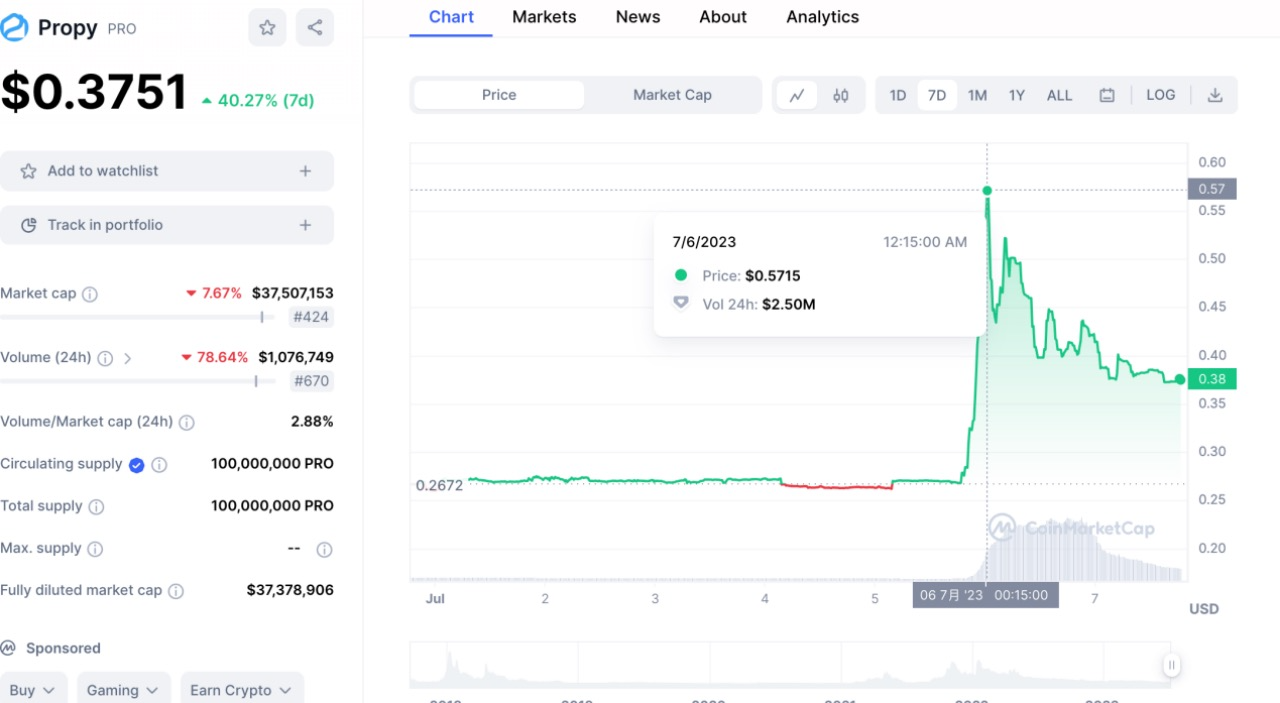
II. Overview of 20 Early-stage projects in 7 RWA sub-sectors
According to the encrypted data platform RootData, the RWA sector currently has nearly 60 projects, with a focus on innovative projects in the areas of on-chain bonds, credit, and real estate. In addition to the previously mentioned leading projects, we have selected early-stage projects in the RWA sector that are worth exploring based on their investment and financing situation, partners, and market attention.
It is worth mentioning that many RWA projects received investments from well-known investors in 2020 and 2021, but their overall development has been relatively slow. The main narrative is still about how to invest encrypted funds into real-world assets such as real estate and bonds, and how borrowers can use real assets as collateral for loans.
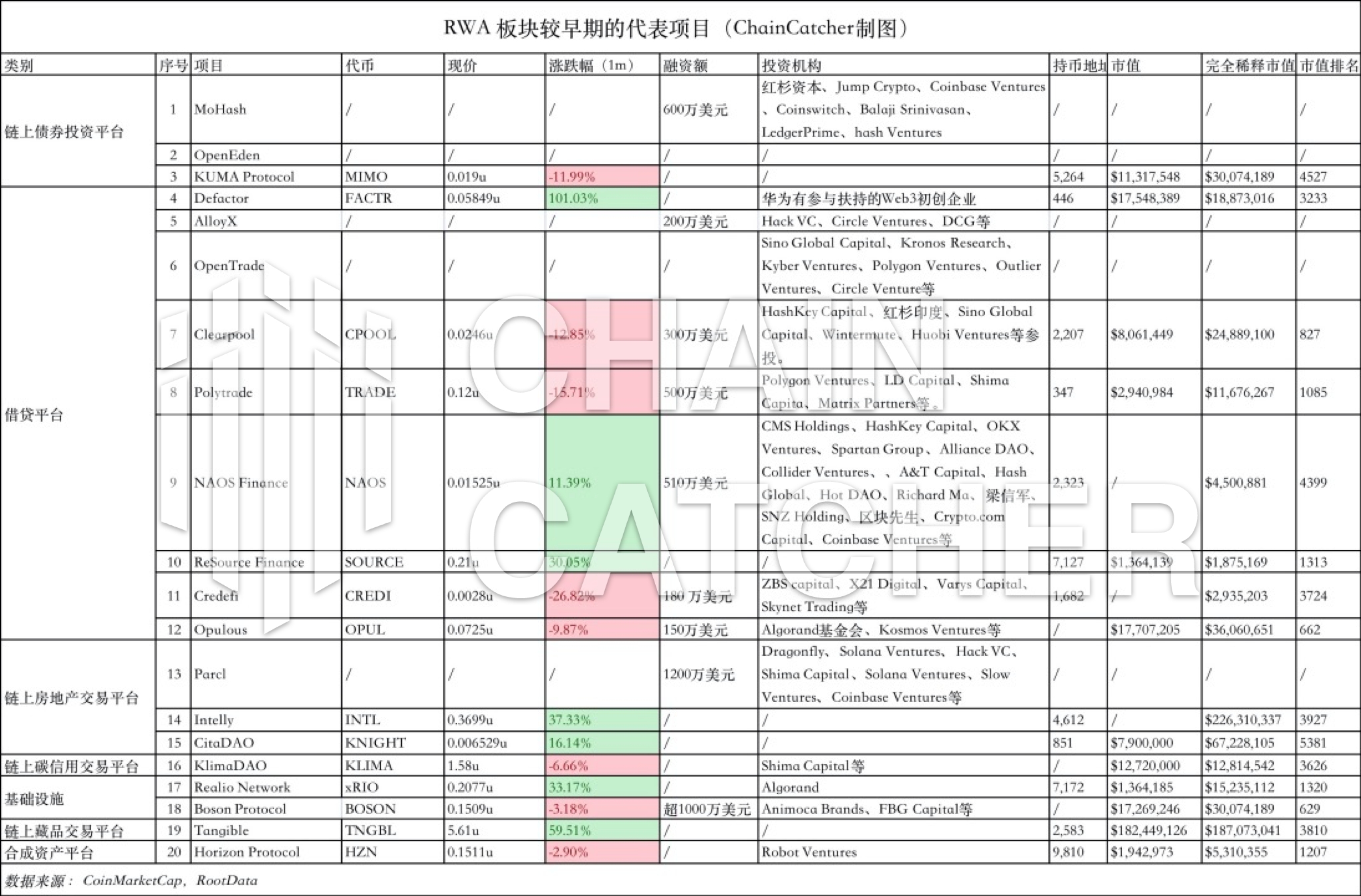
On-chain Bond Investment Platform
1. MoHash
MoHash provides investors with profit products supported by real-world debt assets. In June 2022, MoHash raised a total of $6 million in financing, with leading investment from Sequoia Capital, Jump Crypto, Coinbase Ventures, Coinswitch, Balaji Srinivasan, LedgerPrime, hash Ventures, and others. It is reported that in addition to experimenting with bonds, MoHash has recently been testing the BBZ platform, a pure on-chain asset special options trading platform.
2. OpenEden
OpenEden is an on-chain US debt protocol that allows users to invest in US treasury securities through its native stablecoin TBILL to earn an expected annualized return of 5.3%. TBILL can be redeemed at any time without being restricted by US trading hours. Currently, TBILL TVL has reached $12.96 million.
3, KUMA Protocol (MIMO)
KUMA Protocol is a project recently established this year that provides interest-bearing tokens backed by bonds for investors to earn returns. KUMA Protocol is the result of collaboration between two different organizations: Mimo Labs and the newly formed Kuma DAO. Mimo Capital AG tokenizes bonds using NFT technology, while KUMA Protocol is a decentralized entity managed by MIMO token holders, which utilizes these bond tokens to issue KUMA interest-bearing tokens.
Lending Platform
4, Defactor (FACTR)
Defactor is an investment and financing platform that connects traditional finance and DeFi, providing lending services for small and medium-sized enterprises in traditional finance. Although Defactor is an early-stage project, it is worth mentioning that Defactor was supported by the "Huawei International Scaling Program" held by Huawei and Dogpatch Labs in Ireland. Earlier this year, Huawei's official Twitter account also recommended Defactor, and as a result, the governance token FACTR of Defactor experienced a significant increase, with a maximum increase of about 800%. In the past seven days, FACTR has also seen a growth of over 30% amid the RWA narrative.
5, AlloyX
AlloyX is a decentralized credit protocol. Lenders provide funds to the vault in the form of USDC, and the vault aggregates the assets of the deposited tokens, which are allocated and operated according to preset parameters. By depositing USDC, users receive insurance vault tokens based on floating exchange rates and earn income.
Users can build and customize investment strategies based on their own preferences for returns, risks, and liquidity. AlloyX aggregates investments in almost all credit and US Treasury agreements, including Credix, Goldfinch, Centrifuge, Flux Finance, and Backed Finance.
On June 29th, AlloyX completed a $2 million pre-seed financing and announced the launch of its mainnet, with investors including Hack VC Circle Ventures, DCG, and others.
6. OpenTrade
OpenTrade provides investment opportunities for on-chain supply chain finance products for Web 3 companies. Circle is a partner of OpenTrade, allowing Web 3 companies to provide financing for small and medium-sized enterprises using USDC assets and generate investment returns. OpenTrade recently completed a $1.5 million financing in May, with participation from Sino Global Capital, Kronos Research, Kyber Ventures, Polygon Ventures, Outlier Ventures, and Circle Ventures.
7. Clearpool (CPOOL)
Clearpool is a decentralized credit protocol that allows whitelisted institutions to borrow uncollateralized liquidity from a decentralized lending network. Clearpool raised $3 million in seed financing in 2021, with participation from HashKey Capital, Sequoia India, Sino Global Capital, Wintermute, Huobi Ventures, and others.
The founder of Clearpool also founded Hex Trust, an institutional-grade digital asset custodian, which raised nearly $100 million in funding from renowned institutions.
8. Polytrade (TRADE)
Polytrade and OpenTrade are similar, helping Web 3 investors invest stablecoins in SMEs and earn profits. Currently, the deposits on the Polytrade platform have exceeded $110 million. Polytrade has raised a total of $5 million in two rounds of financing, with investors including Polygon Ventures, LD Capital, Shima Capital, Matrix Partners, etc.
9. NAOS Finance (NAOS)
NAOS Finance is a decentralized lending protocol that allows Web 3 users to lend to traditional industry enterprises and earn fixed-rate returns.
NAOS Finance completed a $5.1 million private placement round of financing in 2021, with participation from up to 30 investors, including CMS Holdings, HashKey Capital, OKX Ventures, Spartan Group, Alliance DAO, Collider Ventures, A&T Capital, Hash Global, Hot DAO, Richard Ma, Liang Xinjun, SNZ Holding, Mr. Blockchain, Crypto.com Capital, Coinbase Ventures, etc.
However, according to NAOS Finance's official Twitter account, NAOS Finance's finances were affected by the collapse of FTX. V2, which was originally scheduled to launch around the end of last year, was unable to go live, and the fund pool data on the official website cannot be displayed. TVL is also shown as zero, but its token has risen over 10% in the past 7 days.
10. ReSource Finance (SOURCE)
ReSource is a decentralized business credit protocol that uses products and services as collateral. The platform automatically creates a novel reputation system to rate creditors and select the best enterprises for expanding credit limits. ReSource utilizes various data oracles to create credit scores by providing data on multiple factors, including FICO credit scores, bank statements, accounting software APIs, and market reviews. ReSource completed a seed round financing of $1.7 million in 2021, with participating investors such as NGC Ventures, BlockRock Capital, Flori Ventures, and others.

11. Credefi (CREDI)
Credefi is a credit protocol that provides encrypted loans for traditional small and medium-sized enterprises in the European Union. Lenders need to provide physical economic assets leases as collateral. At the end of 2021, Credefi completed a seed round financing of $1.8 million.
12. Opulous (OPUL)
Opulous offers music rights NFTs and DeFi loans for musicians and attracts fan investments. Opulous has completed two rounds of financing, including a seed round with $1.5 million raised. Investors include the Algorand Foundation, Kosmos Ventures, and others.
On-Chain Real Estate Trading Platform
13. Parcl
Parcl is a real estate derivatives protocol that allows Web 3 users to go long or short on global real estate markets using their own cryptocurrencies. Parcl launched its mainnet in January of this year and previously raised over $12 million in financing through two rounds. Investors include Dragonfly, Solana Ventures, Hack VC, Shima Capital, Solana Ventures, Slow Ventures, Coinbase Ventures, and others.
14, Intelly (INTL)
Intelly is a fragmented NFT (F-NFT) real estate investment platform. Investors will be able to purchase partial real estate assets on the platform using Intelly's INTL token. In addition to direct wallet investment, Intelly also allows users to pledge cryptocurrencies in their Binance accounts to earn rewards. There are multiple options for the pledge period, including 1 day, 1 week, 1 month, 90 days, 180 days, and 365 days.
Furthermore, Intelly will soon launch the Intelly Exchange, a real estate trading marketplace where property owners can create and publish real estate F-NFTs related to their projects for investors to invest in, with stablecoin rewards. The INTL token has risen by 38% in the past month.
15, CitaDAO (KNIGHT)
CitaDAO is an on-chain real estate investment platform where investors can subscribe to a portion of real estate tokens (Real Estate Tokens) at an agreed price through a real estate project's IRO (Introducing Real Estate On-chain). If they miss the IRO, investors can also directly purchase real estate tokens using USDC and earn rewards.
Investors can choose to provide liquidity by staking the real estate tokens in the liquidity pool to earn rewards in the form of CitaDAO's KNIGHT token.
On-chain carbon credit trading marketplace
16, KlimaDAO (KLIMA)
KlimaDAO is a voluntary carbon credit trading marketplace that has issued an algorithmic currency called KLIMA token, backed by carbon credits, with each KLIMA token pegged to 1 BCT (Basic Carbon Ton) token. Users can generate rewards by staking KLIMA in KlimaDAO. Additionally, KlimaDAO drives the price appreciation of carbon credits in the VCM (Voluntary Carbon Market) by purchasing and stockpiling as many credits as possible in its treasury, encouraging emissions reduction. So far, KlimaDAO's trading volume has exceeded $4 billion.
According to reports, Klima DAO is a forked project of the stablecoin protocol Olympus DAO. It accumulated over $110 million worth of treasury assets within less than a month of launching in late 2021. It is a popular Web 3 project in the carbon credit market. Last year, Polygon announced its purchase of $400,000 worth of traceable carbon credits through KlimaDAO's on-chain carbon market, Klima Infinity.
Infrastructure
17, Realio Network (xRIO)
Realio Network is a Layer 1 blockchain focusing on the issuance and management of digitized real-world assets (RWA). It has received token investments from Algorand.
It's worth mentioning that in the wake of continuous US regulations on the cryptocurrency market this year, the founder of Realio Network criticized the US government's unfriendly stance towards cryptocurrencies in June. The founder stated that since the establishment of the company in 2018, compliance has been a core focus because investing in real-world assets, whether on the blockchain or not, usually requires adherence to securities laws. However, the lack of action from certain US government agencies has made the path to compliance extremely difficult, ultimately leading to the decision to exit the US market.
18, Boson Protocol (BOSON)
Boson Protocol is a public commercial infrastructure that tokenizes, transfers, and trades any physical item as redeemable NFTs. Boson has raised over $10 million in funding, with investors including Animoca Brands and FBG Capital.
Collectible investment platform
19, Tangible (TNGBL)
Tangible is an NFT investment platform where users can invest in real-world physical assets such as gold, wine, and watches. On Tangible, users can use Tangible's stablecoin USDR to purchase physical goods from global suppliers. After successful payment, a TNFT (Tangible non-fungible token) is minted as proof of purchase for the physical item. The physical item is then sent to one of Tangible's secure and insured storage facilities, while the TNFT is sent to the buyer's wallet. Users can also sell goods on Tangible's NFT marketplace backed by physical assets.
It is worth mentioning that Tangible's stablecoin, USDR, generates income mainly as an over-collateralized stablecoin with tokenized real estate as collateral, and holding this stablecoin can generate income. Currently, Tangible's Total Value Locked (TVL) has reached $51.18 million, with a token price increase of over 40% in the past month.
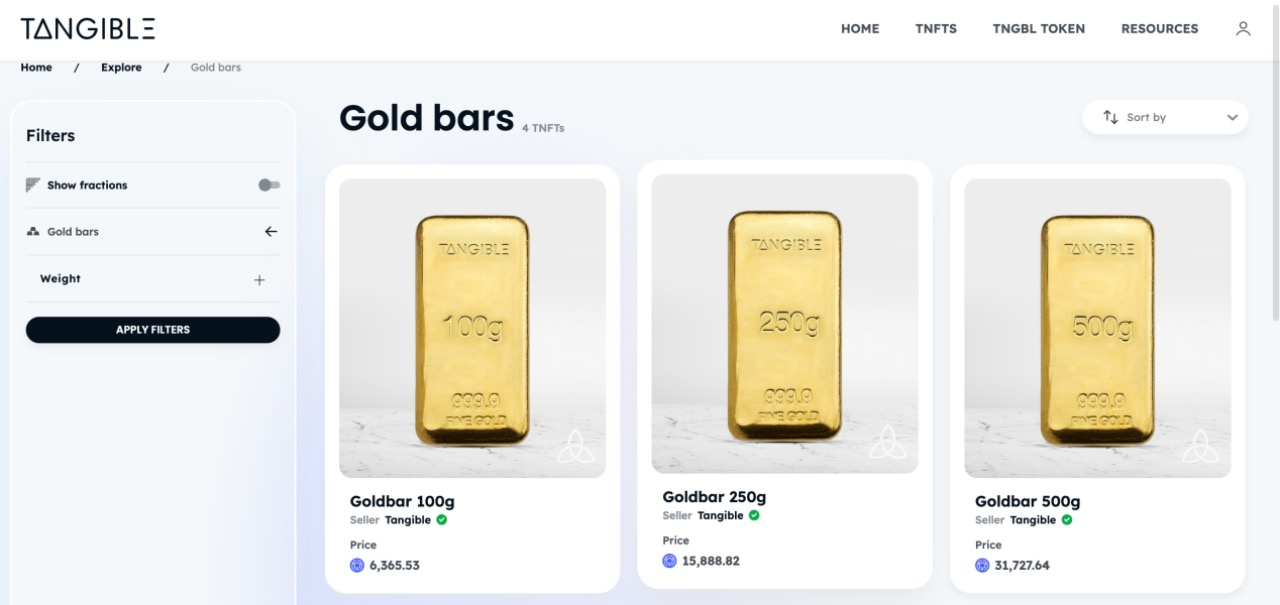
Synthetic Assets
20. Horizon Protocol (HZN)
Horizon Protocol is a synthetic asset platform on the Binance Smart Chain. The synthetic assets on Horizon Protocol, called "zAssets," can track the price movements and risk-return profiles of traditional assets such as stocks, commodities like gold and oil, currencies like USD and EUR, and cryptocurrencies like Bitcoin. Users can pledge their HZN to mint synthetic assets (zAssets) and earn interest.



